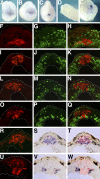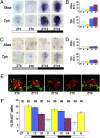Xenopus Bsx links daily cell cycle rhythms and pineal photoreceptor fate
- PMID: 20308548
- PMCID: PMC2852004
- DOI: 10.1073/pnas.1000854107
Xenopus Bsx links daily cell cycle rhythms and pineal photoreceptor fate
Abstract
In the developing central nervous system, the cell cycle clock plays a crucial role in determining cell fate specification. A second clock, the circadian oscillator, generates daily rhythms of cell cycle progression. Although these two clocks interact, the mechanisms linking circadian cell cycle progression and cell fate determination are still poorly understood. A convenient system to address this issue is the pineal organ of lower vertebrates, which contains only two neuronal types, photoreceptors and projection neurons. In particular, photoreceptors constitute the core of the pineal circadian system, being able to transduce daily light inputs into the rhythmical production of melatonin. However, the genetic program leading to photoreceptor fate largely remains to be deciphered. Here, we report a previously undescribed function for the homeobox gene Bsx in controlling pineal proliferation and photoreceptor fate in Xenopus. We show that Xenopus Bsx (Xbsx) is expressed rhythmically in postmitotic photoreceptor precursors, reaching a peak during the night, with a cycle that is complementary to the daily rhythms of S-phase entry displayed by pineal cells. Xbsx knockdown results in increased night levels of pineal proliferation, whereas activation of a GR-Xbsx protein flattens the daily rhythms of S-phase entry to the lowest level. Furthermore, evidence is presented that Xbsx is necessary and sufficient to promote a photoreceptor fate. Altogether, these data indicate that Xbsx plays a dual role in contributing to shape the profile of the circadian cell cycle progression and in the specification of pineal photoreceptors, thus acting as a unique link between these two events.
Conflict of interest statement
The authors declare no conflict of interest.
Figures





Similar articles
-
Circadian regulation and molecular role of the Bsx homeobox gene in the adult pineal gland.J Pineal Res. 2020 Mar;68(2):e12629. doi: 10.1111/jpi.12629. Epub 2019 Dec 30. J Pineal Res. 2020. PMID: 31808568 Free PMC article.
-
Multiple circadian oscillators in the photosensitive pike pineal gland: a study using organ and cell culture.J Pineal Res. 1994 Mar;16(2):77-84. doi: 10.1111/j.1600-079x.1994.tb00086.x. J Pineal Res. 1994. PMID: 8014827
-
Otx2 homeobox gene controls retinal photoreceptor cell fate and pineal gland development.Nat Neurosci. 2003 Dec;6(12):1255-63. doi: 10.1038/nn1155. Epub 2003 Nov 16. Nat Neurosci. 2003. PMID: 14625556
-
Nonvisual photoreceptors of the deep brain, pineal organs and retina.Histol Histopathol. 2002 Apr;17(2):555-90. doi: 10.14670/HH-17.555. Histol Histopathol. 2002. PMID: 11962759 Review.
-
Encoding time of day and time of year by the avian circadian system.J Neuroendocrinol. 2003 Apr;15(4):398-404. doi: 10.1046/j.1365-2826.2003.01003.x. J Neuroendocrinol. 2003. PMID: 12622840 Review.
Cited by
-
Circadian regulation and molecular role of the Bsx homeobox gene in the adult pineal gland.J Pineal Res. 2020 Mar;68(2):e12629. doi: 10.1111/jpi.12629. Epub 2019 Dec 30. J Pineal Res. 2020. PMID: 31808568 Free PMC article.
-
Homeobox genes in the rodent pineal gland: roles in development and phenotype maintenance.Neurochem Res. 2013 Jun;38(6):1100-12. doi: 10.1007/s11064-012-0906-y. Epub 2012 Oct 18. Neurochem Res. 2013. PMID: 23076630 Free PMC article. Review.
-
Type II Opsins in the Eye, the Pineal Complex and the Skin of Xenopus laevis: Using Changes in Skin Pigmentation as a Readout of Visual and Circadian Activity.Front Neuroanat. 2022 Jan 21;15:784478. doi: 10.3389/fnana.2021.784478. eCollection 2021. Front Neuroanat. 2022. PMID: 35126061 Free PMC article. Review.
-
Circadian changes in long noncoding RNAs in the pineal gland.Proc Natl Acad Sci U S A. 2012 Aug 14;109(33):13319-24. doi: 10.1073/pnas.1207748109. Epub 2012 Aug 3. Proc Natl Acad Sci U S A. 2012. PMID: 22864914 Free PMC article.
-
Brain-specific homeobox Bsx specifies identity of pineal gland between serially homologous photoreceptive organs in zebrafish.Commun Biol. 2019 Oct 7;2:364. doi: 10.1038/s42003-019-0613-1. eCollection 2019. Commun Biol. 2019. PMID: 31602413 Free PMC article.
References
-
- Ohnuma S, Harris WA. Neurogenesis and the cell cycle. Neuron. 2003;40:199–208. - PubMed
-
- Andreazzoli M. Molecular regulation of vertebrate retina cell fate. Birth Defects Res., Part C. 2009;87:284–295. - PubMed
-
- Okamura H. Clock genes in cell clocks: Roles, actions, and mysteries. J Biol Rhythms. 2004;19:388–399. - PubMed
-
- Hunt T, Sassone-Corsi P. Riding tandem: Circadian clocks and the cell cycle. Cell. 2007;129:461–464. - PubMed
-
- Roenneberg T, Foster RG. Twilight times: Light and the circadian system. Photochem Photobiol. 1997;66:549–561. - PubMed
Publication types
MeSH terms
Substances
Grants and funding
LinkOut - more resources
Full Text Sources
Research Materials

